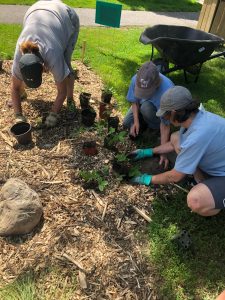Inspired by the micro-forest idea and an aim to increase biodiversity in our parks, the Enviro Crew of Old Ottawa South designed and planted two mini-meadows at Brighton Beach Park. The Enviro Crew works under the Environment and Climate Action Committee of the Old Ottawa South Community Association.
This small neighbourhood park is very well used by surrounding residents and people walking or biking along the river. One of the first things we did was consult those residents and were delighted when several volunteered to help. They were a wealth of information about the history of the area as well as current uses of the park, for example for an annual neighbourhood get together.
We applied to the city for “permission to enter city property.” This took a very long time; starting at the end of January was not soon enough. We also applied for a city environment grant – a modest $1000, and our budget was approved. We submitted the description and map to One-Call, to see whether there was any underground infrastructure to be avoided. The answer was no.
We outlined potential beds with rope, made adjustments for nearby trees, a hydro guy wire, garbage pails, future widening of the paved path. The city kindly delivered a load of wood chips to use as mulch.
How we did it
With an outline in place, we scraped off the sod/weeds. We decided not to throw away this resource, so we shook soil off roots back into the bed and tossed the grass and weeds into the middle of each bed to form a low berm. We also collected large stumps, logs, and rocks to place between plants and near the edges of the beds. These create a microclimate for plants – you can heat up an area by placing a light-coloured rock behind the plants, create shade with a stump, or shelter more delicate plants between angled logs. We tried not to choose delicate plants, of course, but we also didn’t want soccer balls squashing anemones.

“Before” – this lovely little park is well used, but it contains only trees – no flowers, no longer grasses, no shrubs. This is the outline for the lower meadow. You can just see the upper meadow at the other end of the path.

Almost “after! The lower meadow with most plants in place. The adjacent river provided water, although it was heavy to carry. A neighbour came out with a hose and very kindly watered the upper meadow.
Thanks to an amazing team of volunteers and the encouragement of many neighbours and other passers-by, we were able to prepare the beds, plant, add rocks and logs, mulch, and water all over the Canada Day weekend.
We planted in clumps, putting the three Red-osier Dogwoods together in the lower bed, the Gray Dogwoods in the upper bed. Strawberries went along the path edge in one bed, silverweed in the other. Then low plants (Canada Anemone, Pearly Everlasting) next and taller ones further back (Flat-topped Aster, Sneezeweed, Mountain Mint).
Half the wildflowers were donated by the Fletcher Wildlife Garden; the other half and the shrubs (which came from Ferguson Forest Tree Nursery) were covered by our environment grant. I was disappointed at how small they look, although I know from experience that by the end of next summer, these perennials will be flourishing.
Plant list
| Upper meadow | Lower meadow |
| Red Osier Dogwood Ninebark Wild Strawberries Prairie Dropseed Great Blue Lobelia Pearly Everlasting Tall Cinquefoil Rough-stemmed Goldenrod New England Aster Grass-leafed Goldenrod Blazing Star Wild Bergamot Yarrow |
Gray Dogwood Ninebark Silverweed Canada Anemone Great Blue Lobelia Flat-topped Aster Tall Cinquefoil Rough-stemmed Goldenrod Mountain Mint Sneezeweed Nodding Onion Hairy Beardtongue Yarrow |
Future
We are very much looking forward to watching the plants settle in and bloom in their season. Some may not survive. That’s a Black Walnut tree next to the lower meadow, so we are prepared to swap out some of the plants if they are inhibited by its chemicals. We’ll need to water during the summer. In fall, we’ll meet to see what needs to be done to prepare for winter. The still-small shrubs might have to be protected. Weeding will certainly be needed.
We’ve planned for maintenance only twice a year, in spring and fall, but we’re ready to revise that schedule if necessary.
2023 update
After a slow start, the small plants grew well in summer 2022, and some even bloomed – New England Asters, Great Blue Lobelia, Pearly Everlasting. A neighbour very kindly watered the Brighton Meadow. We brought buckets of water from the river to Fentiman during dry spells. Weeding was necessary, but not as much as expected.
In late fall, we installed wire “cages” around the shrubs to protect them from the weight of snow – and snowplows.
All plants survived the winter, so we put the meadows on a list of Wild Pollinator Partners garden tours. In preparation for that event, we weeded the beds, but that required only minimal work – pulling out dandelions and Manitoba Maple seedlings. We tucked the weeds back into the beds, out of sight under shrubs.
By fall, the wildflowers were spilling out of their beds, and we are planning to divide some. The New England Asters, in particular, grew larger than the adjacent Red Osier Dogwood shrubs, so may be too robust for this situation. We trimmed the shrubs by cutting back any long branches – to make them more compact and bushier.

Plants in the Fentiman meadow are not as large as Brighton, possibly because of the proximity of a Black Walnut tree. This bed is partly shaded as well.

New England Asters in the Brighton Meadow grew aggressively and might have to be removed from this bed.
